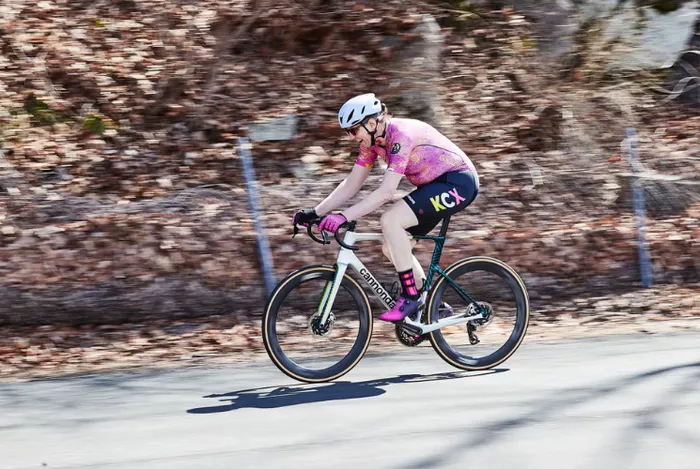A simple and low-cost handlebar upgrade can increase speed and reduce drag, giving everyday riders a taste of pro-level aerodynamics.
Why Aerodynamics Matter in Cycling
Aerodynamics has long been a focus in road cycling. Today, gravel riders are also paying more attention to it. The faster you ride, the more energy you use to fight air resistance. Using aerodynamic gear and body positioning helps reduce drag and improve speed.
Professional riders use deep-section wheels, aero helmets, and skinsuits to save seconds. But it’s not just for pros. Anyone chasing personal records or trying to ride longer with less fatigue can benefit from aero improvements.
Making Simple Adjustments for Aero Gains
A good way to reduce drag is by lowering your frontal profile. This is often done by riding in the drops, but it can be uncomfortable for long periods. Most riders spend more time on the hoods, where comfort is higher.
To improve aerodynamics in this position, some cyclists angle their brake levers inward. This approach has become so popular that brands like Shimano and SRAM now design their components to allow inward angles.
Another way to reduce frontal area is by using narrower handlebars. However, too narrow bars can hurt bike handling. This is where flared handlebars come in—they offer a narrow grip at the hoods but wider drops for control.
Flared Handlebars: A Growing Trend
Flared bars first gained popularity among gravel riders who needed better control on rough terrain. Brands like PNW, Salsa, and Redshift make ultra-wide flared bars. These are often too wide for road riders, who want better aerodynamics without losing handling.
Several brands now offer flared bars suited to road bikes. Enve’s Aero In-Route bar is 5cm narrower at the hoods than at the drops. Trek’s Bontrager RSL Aero bar is 3cm narrower. Zipp’s SL-80 Race bar also flares at the drops for added control. But these options cost between $340 and $450, which can be too expensive for many riders.
A Budget-Friendly Aero Solution
During testing for Trek’s Madone SL5, a budget model in their aero lineup, testers noticed it featured an affordable aluminum flare bar. This bar closely resembles the $700 integrated bar used on Trek’s top-tier Madone SLR9. Trek sells this aluminum Bontrager Comp Road bar for just $70.
To evaluate the bar’s performance, two riders tested it on a familiar five-mile route. They also tested a standard 42cm bar and a wider flared bar for comparison. The tests were done in consistent conditions using the same bikes and power output.
Timed Test Results
Both testers found the 36cm hood-width flare bar was the fastest. One rider saved 12 seconds, the other saved 5 seconds over 5 miles compared to the standard bar. Over longer rides, this adds up to significant time savings—about a minute over 25 miles and four minutes over a century ride.
Interestingly, the wider 380/420mm flare bar was slower than even the standard 42cm bar. This was likely because moving the brake levers inward raised the riders’ upper bodies, increasing frontal drag. In contrast, the 360/400mm bar narrowed the profile enough to offset that change in position.
Expert Opinion on Handlebar Width
Josh Poertner, president of Silca and an aero expert, reviewed the test results. He noted that narrower bars often require longer stems to keep riders from becoming too upright. Without adjusting the stem or reach, narrower bars can actually reduce aero efficiency by pushing riders upward or causing “chicken wings” where elbows stick out.
Elite athletes use wind tunnels and video analysis to fine-tune their positions. Tools like multi-angle cameras and outline overlays help experts like Poertner spot tiny details that impact speed.
Real-World Riding Experience
After a month of regular riding, testers found the flare bars not only improved speed but also remained comfortable. One tester noted a noticeable aerodynamic gain with the 360/400mm bar and quickly adapted to the more responsive handling. The other tester, using the 380/420mm bar, needed a few adjustments to match their usual position but eventually felt at ease.
The narrower hood position makes the bike feel more reactive, especially when riding on the hoods. But overall, the trade-off between speed and handling was well worth it.
Conclusion: Aero Gains on a Budget
The $70 Bontrager Comp Road bar offers a significant performance boost at a fraction of the cost of premium aero bars. Riders looking for a simple upgrade can enjoy better aerodynamics without compromising comfort or spending hundreds of dollars. Whether you’re training for a century or chasing personal bests, this budget bar could be your easiest aero win.
Related topics
- Is Road Cycling Good for Weight Loss?
- How Long Do You Need to Bike to Lose Weight?
- What Benefits Do You Get From Cycling?

